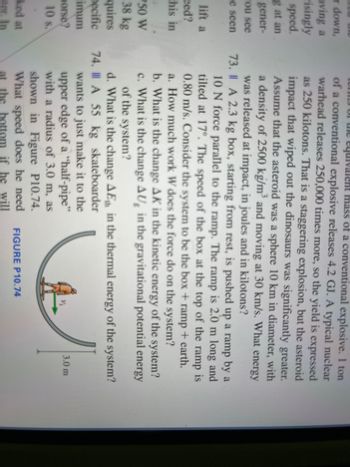
College Physics
11th Edition
ISBN: 9781305952300
Author: Raymond A. Serway, Chris Vuille
Publisher: Cengage Learning
expand_more
expand_more
format_list_bulleted
Concept explainers
Question
Question 73 part a

Transcribed Image Text:**Educational Content: Physics - Energy and Work**
**Problem 74: Skateboarder in a Half-Pipe**
A 55 kg skateboarder wants to just make it to the upper edge of a "half-pipe" with a radius of 3.0 m, as shown in Figure P10.74.
**Figure P10.74:**
- The figure illustrates a skateboarder at the bottom of a half-pipe.
- The half-pipe has a curved shape with a radius of 3.0 meters.
- \( v_i \) is the initial speed of the skateboarder at the bottom of the half-pipe pointing upwards.
**Questions:**
a. What initial speed does the skateboarder need at the bottom if he is to reach the upper edge?\
b. If the skateboarder starts from rest in the pipe at the bottom with an initial speed found in (a), what will be the kinetic energy at the bottom?
c. Find the gravitational potential energy at the top of the half-pipe in terms of mgh, where m=mass, g=gravitational constant, h=height.
**Problem 73: Work Done by Forces on a Box**
A 2.3 kg box, starting from rest, is pushed up a ramp by a 10 N force parallel to the ramp and tilted at 17°. The speed of the box at the top of the 2.0 m ramp is 0.80 m/s. Consider the system to be the box + ramp + earth.
**Questions:**
a. How much work \( W \) does the 10 N force do on the system?\
b. What is the change \( \Delta U \) in the gravitational potential energy of the system?\
c. What is the change \( \Delta K \) in the kinetic energy of the system?\
d. What is the change \( \Delta E \) in the thermal energy of the system?
Expert Solution
This question has been solved!
Explore an expertly crafted, step-by-step solution for a thorough understanding of key concepts.
Step by stepSolved in 4 steps

Knowledge Booster
Learn more about
Need a deep-dive on the concept behind this application? Look no further. Learn more about this topic, physics and related others by exploring similar questions and additional content below.Similar questions
- Acceleration of a rocket at launch Rebound of a basketball off the backboard Occupant protection in an automobile crash Proportional to velocity Proportional to square of velocity A. Elastic collision B. Kinetic energy C. Inelastic collision D. Conservation of momentum and thrust E. Momentumarrow_forwardhelp Find the mass of an object that is moving at 14 m/s and has a momentum of 182 kg m/sarrow_forwardA 0.185 kg golf club swings and hits a 0.045 kg ball. You are able to hit the ball in the elastic sweet spot which changes the velocity from 44 m/s to 32 m/s. What is the velocity of the ball after it leaves the golf clubarrow_forward
arrow_back_ios
arrow_forward_ios
Recommended textbooks for you
 College PhysicsPhysicsISBN:9781305952300Author:Raymond A. Serway, Chris VuillePublisher:Cengage Learning
College PhysicsPhysicsISBN:9781305952300Author:Raymond A. Serway, Chris VuillePublisher:Cengage Learning University Physics (14th Edition)PhysicsISBN:9780133969290Author:Hugh D. Young, Roger A. FreedmanPublisher:PEARSON
University Physics (14th Edition)PhysicsISBN:9780133969290Author:Hugh D. Young, Roger A. FreedmanPublisher:PEARSON Introduction To Quantum MechanicsPhysicsISBN:9781107189638Author:Griffiths, David J., Schroeter, Darrell F.Publisher:Cambridge University Press
Introduction To Quantum MechanicsPhysicsISBN:9781107189638Author:Griffiths, David J., Schroeter, Darrell F.Publisher:Cambridge University Press Physics for Scientists and EngineersPhysicsISBN:9781337553278Author:Raymond A. Serway, John W. JewettPublisher:Cengage Learning
Physics for Scientists and EngineersPhysicsISBN:9781337553278Author:Raymond A. Serway, John W. JewettPublisher:Cengage Learning Lecture- Tutorials for Introductory AstronomyPhysicsISBN:9780321820464Author:Edward E. Prather, Tim P. Slater, Jeff P. Adams, Gina BrissendenPublisher:Addison-Wesley
Lecture- Tutorials for Introductory AstronomyPhysicsISBN:9780321820464Author:Edward E. Prather, Tim P. Slater, Jeff P. Adams, Gina BrissendenPublisher:Addison-Wesley College Physics: A Strategic Approach (4th Editio...PhysicsISBN:9780134609034Author:Randall D. Knight (Professor Emeritus), Brian Jones, Stuart FieldPublisher:PEARSON
College Physics: A Strategic Approach (4th Editio...PhysicsISBN:9780134609034Author:Randall D. Knight (Professor Emeritus), Brian Jones, Stuart FieldPublisher:PEARSON

College Physics
Physics
ISBN:9781305952300
Author:Raymond A. Serway, Chris Vuille
Publisher:Cengage Learning

University Physics (14th Edition)
Physics
ISBN:9780133969290
Author:Hugh D. Young, Roger A. Freedman
Publisher:PEARSON

Introduction To Quantum Mechanics
Physics
ISBN:9781107189638
Author:Griffiths, David J., Schroeter, Darrell F.
Publisher:Cambridge University Press

Physics for Scientists and Engineers
Physics
ISBN:9781337553278
Author:Raymond A. Serway, John W. Jewett
Publisher:Cengage Learning

Lecture- Tutorials for Introductory Astronomy
Physics
ISBN:9780321820464
Author:Edward E. Prather, Tim P. Slater, Jeff P. Adams, Gina Brissenden
Publisher:Addison-Wesley

College Physics: A Strategic Approach (4th Editio...
Physics
ISBN:9780134609034
Author:Randall D. Knight (Professor Emeritus), Brian Jones, Stuart Field
Publisher:PEARSON